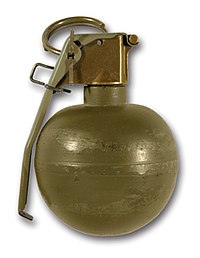Fragmentation grenade


This article needs additional citations for verification. (September 2014) |
A fragmentation grenade (commonly known as frag or frag grenade) is a high explosive anti-personnel grenade that is designed to disperse small projectiles or fragments on detonation. The body may be made of hard plastic or steel. The outer casing and/or a fragmentation matrix consisting of notched wire and preformed fragments (spherical or otherwise) provide the projectiles. When the word grenade is used without specification, and context does not suggest otherwise, it is generally assumed to refer to a fragmentation grenade.
Models of grenades are normally intended for either offensive or defensive use. Defensive grenades have a smaller effective casualty radius, but also less risk of fragments hitting the thrower. Mills bombs and the Soviet F1 are examples of defensive grenades.
The Dutch V40, Swiss HG 85, and US M67 are offensive grenades as they have an effective wounding radius of around 15 m and can easily be thrown further. Fragments may travel more than 200 m.[1]
References
- ^ Federation of American Scientists. M67 FRAGMENTATION HAND GRENADE
